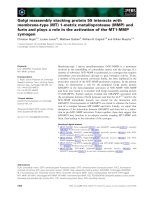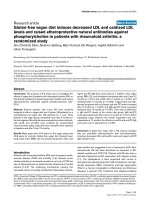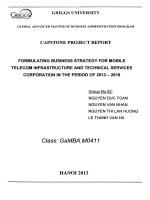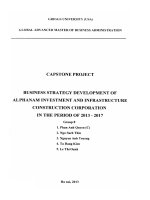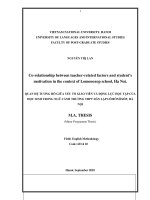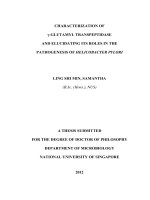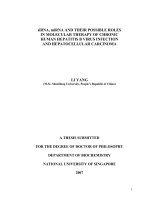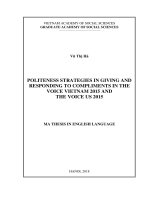ceruloplasmin and oxidized ldl colocalize in atherosclerotic lesions of hamster
Bạn đang xem bản rút gọn của tài liệu. Xem và tải ngay bản đầy đủ của tài liệu tại đây (2.09 MB, 9 trang )
Cent. Eur. J. Biol. • 6(1) • 2011 • 23–31
DOI: 10.2478/s11535-010-0076-3
Central European Journal of Biology
Ceruloplasmin and oxidized LDL colocalize
in atherosclerotic lesions of hamster
Research Article
Camelia Stancu1,*, Elena Constantinescu2, Anca Sima1
Lipoproteins and Atherosclerosis Department,
Institute of Cellular Biology and Pathology “Nicolae Simionescu”,
050568 Bucharest, Romania
1
Cerebrovascular Dysfunction in Ageing Disease Department,
Institute of Cellular Biology and Pathology “Nicolae Simionescu”,
050568 Bucharest, Romania
2
Received 07 May 2010; Accepted 08 July 2010
Abstract: Epidemiological studies show that the risk for cardiovascular diseases increases with increasing levels of free-copper in plasma. It is
known that intact ceruloplasmin (CP), the major protein transporter of copper in human plasma, oxidizes low density lipoproteins (LDL)
in vitro. Our aim was to study the interaction between LDL and CP in vitro and in vivo, in an animal model of diet-induced atherosclerosis.
In order to visualize the pathway of LDL into the arterial wall, human native LDL was labeled with fluorescent DiI and injected into male,
Golden Syrian hyperlipemic hamsters. In vitro results demonstrated that slightly degraded CP has a significant oxidation potential against
LDL at neutral pH. In vivo, after 24 hours circulation, LDL-DiI was taken up by the enlarged intima and fatty streaks of the arterial wall.
Immunohistochemical localization of oxidized LDL and CP revealed their presence in the same areas of the arteries that take up LDL-DiI.
Co-localization of LDL and CP in the enlarged intima of pro-atherosclerotic areas might explain the possible copper-induced oxidation process
that might occur after native LDL is taken-up from the blood, transcytosed through the endothelium and accumulated in focalized deposits.
Keywords: Atheroma • Ceruloplasmin • Fatty streak • Hyperlipemic hamster • LDL • Oxidized LDL
© Versita Sp. z o.o.
Abbreviations
1. Introduction
CP
CVD
DiI
Atherosclerosis is a complex multifactorial disease,
which develops in the arterial wall in response to various
stimuli and results in excessive inflammatory and fibroproliferative reactions. A characteristic sequence of
events has been observed in all lesion-prone areas of
the vasculature, including the cardiac valves, aortic
arch, coronary and carotid arteries [1,2]. These are the
focal sites where atherosclerosis develops in humans,
as well as in animal models of saturated fat-induced
atherosclerosis, such as the hyperlipemic Golden Syrian
hamster [3]. Plasma hyperlipemia generates increased
transcytosis of atherogenic lipoproteins, leading to
their accumulation within and outside the endothelial
cell hyperplasic basement membrane, against the
fragmented internal elastic lamina [4]. Modification of
- ceruloplasmin;
- cardiovascular disorders;
-1,1’-dioctadecyl-3s,3,3’,3’tetramethylindocarbocyanine perchlorate;
LDL
- low density lipoproteins;
MDA
- malondialdehyde;
nLDL
- native LDL;
noxLDL
- native oxidable LDL (without antioxidant
protection);
oxLDL
- oxidized LDL;
PB
- phosphate buffer;
PBS
- phosphate buffer saline;
Rf
- relative electrophoretic mobility;
SDS-PAGE - sodium dodecyl sulfate – polyacrylamide
gel electrophoresis.
* E-mail:
23
Ceruloplasmin and oxidized LDL colocalize
in atherosclerotic lesions of hamster
the low density lipoproteins (LDL), mostly by oxidation,
is believed to play an important role in human atheroma
formation [5-7].
Extensive LDL oxidation in the atherosclerotic
lesions may require a source of iron or copper as
catalysts for the oxidation. The main copper carrier in
plasma is ceruloplasmin (CP); it is an abundant, blue
plasma protein (metalloenzyme) that possesses both
anti-oxidant properties (e.g. ferroxidase activity) and
pro-oxidant potential. Elevated circulating CP levels are
associated with cardiovascular disease (CVD) [8]. There
is also evidence that the risk factors for CVD, in particular,
diabetes mellitus and hyperhomocysteinaemia, may
augment the vasculopathic impact of CP [9]. Another
possibility is for reactive oxygen species to disrupt
copper bound to CP, thereby impairing the protective
function of the latter, while liberating copper, which in
turn may promote oxidative reactions [9] .
Our hypothesis was that in areas with increased
trans-endothelial transport, an increased transport
of native LDL and ceruloplasmin from the lumen into
the arterial wall could take place and thus increase
the oxidation of sub-endothelial LDL. Another source
of ceruloplasmin could be the monocyte-derived
macrophages [10] located in the fatty streak areas of
the artery.
Looking for the impact of CP on transcytosed
LDL accumulated in the arterial intima, we have first
evaluated the potential and the necessary conditions
for CP to induce LDL oxidation in vitro, and further
immuno-localized LDL and CP in the arterial intima
of hyperlipemic hamsters. Results show that in vitro
incubation of native LDL (nLDL) with slightly degraded
human CP (commercially available) at neutral pH
induces the oxidation of LDL. Injection of fluorescently
labelled human nLDL in the blood of hyperlipemic male
Golden Syrian hamsters lead to the accumulation of
lipoproteins within the enlarged intima and fatty streaks,
where oxidized LDL (oxLDL) and CP have been colocalized.
2. Experimental Procedures
2.1 Materials
Ceruloplasmin was obtained from Calbiochem
(La Jolla, CA, USA), 1’-dioctadecyl-3,3,3’,3’tetramethyl-indocarbocyanine
perchlorate
(DiI)
from Molecular Probes, USA. Enzymatic kits
for cholesterol and triglycerides determination
were purchased from Dialab (Austria), and
2,2’-diazobis (2-amidino-propane) dihydrochloride
(AAPH) was purchased from Sigma - Aldrich (USA);
24
2,7-dichlorofluorescein-diacetate (DCFH-DA) and
6-hydroxy-2,5,7,8-tetramethylchroman-2-carboxilic
acid (Trolox) were obtained from Fluka Chemie,
Germany. Other chemicals and reagents were
purchased from Sigma (Saint Louis, MO, USA) if not
otherwise stated.
The primary antibodies used were mouse
monoclonal antibody anti-human oxLDL (a generous
gift from Prof. Paul Holvoet) and whole serum goat
anti-human CP (Sigma-Aldrich, USA). Goat anti-mouse
and Rabbit anti-goat IgG conjugated with horseradish
peroxidase (HRP) were the second antibodies used
(Sigma-Aldrich, USA).
2.2 Animals
Adult (80-100 g body weight) male Golden Syrian
hamsters were kept in standard housing conditions
with free access to rodent chow and maintained
on a 12 hours light/dark cycle. Animals were fed
either standard chow (N) (n=10) or standard chow
supplemented with 3% cholesterol and 15% butter
(hyperlipemic, HL) (n=20).
All experimental procedures were conducted in
accordance with the Guide for the Care and Use of
Laboratory Animals published by the Institutional
Animal Care and Use Committee, April 1997, Oakland
University, USA.
2.3 LDL isolation
LDL was isolated from the plasma of healthy donors
from the Blood Transfusion Center Bucharest by density
gradient ultracentrifugation [11]. The LDL fraction was
collected, dialysed against phosphate buffer saline
(PBS), pH 7.4, at 4°C in the dark, stored under sterile
conditions with EDTA (noxLDL) or EDTA and BHT
(nLDL) and used within 7 days. Before use, LDL was
dialysed against PBS, pH 7.4, at 4°C, in the dark, to
remove EDTA.
2.4 In vitro modification of LDL
Copper-oxidized LDL was prepared by incubating
noxLDL under sterile conditions with 10 µM copper
chloride (24 hours, at 37°C), in the absence of antioxidant
protection. The oxidative reaction was stopped by
adding 1 mg/ml EDTA; after extensive dialysis against
PBS, pH 7.4, 4°C, oxLDL was stored at 4°C, under
sterile conditions and used within 7 days.
2.5 Fluorescent LDL preparation
Human LDL was labelled with DiI as described [12]. The
integrity of LDL protein following DiI labelling was verified
by denaturing polyacrilamide gel electrophoresis (SDSPAGE).
C. Stancu et al.
2.6 Ceruloplasmin preparation
2.10 In vivo uptake of LDL-DiI
2.7 Characterization of CP-modified LDL
2.11 Immunohistochemical localization of LDL
and CP
CP had an A610nm/A280 ratio of 0.02 which is consistent
with a slightly degraded copper-protein complex [13].
SDS-PAGE indicated a major molecular weight band
of 132,000 kDa. CP was pre-incubated (400 µg/ml) in
50 mM phosphate buffer (PB) at either pH 7 or pH 5,
for 24 hours, at 37°C. It was then incubated with either
nLDL, or noxLDL, using a ratio of 200 µg CP/mg LDLcholesterol, similar to the physiological conditions.
Lipid peroxides were evaluated spectrofluorimetrically
using excitation at λ=360 nm and emission at λ=430 nm.
The protein degradation of LDL was measured by
following the decrease of tryptophane fluorescence
(Ex 295 nm/Em 360 nm). The lipid peroxides level was
determined as thiobarbituric acid reactive substances
(TBARS) and expressed as nmoles malondialdehyde
(MDA)/mg LDL-cholesterol [14]. The electric charge
of noxLDL and nLDL was determined by agarose gel
electrophoresis (0.6%) and expressed as relative
electrophoretic mobility (Rf). SDS-PAGE was employed
to characterize apoB from LDL.
2.8 Serum assays
Blood was collected from the venous orbital plexus
of fasted animals (lightly anesthetized with 50 mg
chloral hydrate/100 g body weight) and processed
for determination of total cholesterol, triglycerides,
total antioxidant trapping potential (TRAP), and total
lipid peroxides (TBARS). TRAP was determined as
described by Niculescu et al. [15].
2.9 Tissue preparation for light microscopy
Hamsters were anesthetized and after laparatomy and
catheterization of the abdominal aorta, and the blood
was perfusion-washed with PBS supplemented with
0.1% CaCl2 and 2.25% glucose at 37°C, for 10 min
(4 ml/minute) using the vena cava as an outlet. Under
the same conditions, a mixture of 2% paraformaldehyde
in 0.1 M PB, pH 7.4, or PLP fixative (Nakane’s fixative:
2% paraformaldehyde and 0.075 lysine in 0.01 M Na
periodate) was perfused. After 10 min of in situ fixation
under normal pressure, the aortic arches were kept in the
same fixative for another 2 to 4 h at room temperature.
After washing with PBS, specimens were immersed in
PBS containing 5%, 10%, and 20% sucrose with 10%
glycerol at 4ºC for 15 min, 1 h, and 10 h, respectively.
Specimens were frozen in isopentane cooled with liquid
nitrogen and stored at -70°C. Thick sections (5-10 µm)
from the OCT embedded samples were cut on a Harris
cryostat at -30°C and mounted on 2% gelatine-coated
slides.
LDL-DiI was administrated intravenously to animals
under anaesthesia and maintained in the circulation
for 24 h. The hamsters were then sacrificed, the
abdominal aorta catheterized and the vasculature
perfusion-washed with PBS pH 7.4 at 37°C, using vena
cava as outlet, followed by perfusion-fixation with 2%
paraformaldehyde for 10 min. The aortic arches were
collected for freezing and cryosectioning.
Both hamster LDL and CP gave a single precipitation line
with anti-human oxLDL and anti-human ceruloplasmin,
respectively, as verified by Ouchterlony double
immunodiffusion (data not shown).
To immuno-localize oxLDL and CP, an indirect
immunoperoxidase procedure was used [16]. Briefly,
after fixation the residual aldehyde groups were
quenched with 0.05 M NH4Cl in 0.01 M PBS, pH
7.4, for 20 min at room temperature. Endogenous
peroxidase activity was quenched with 0.3% H2O2
applied on sections for 10 min. Non-specific binding
was blocked by specimens’ incubation with 10%
normal goat or mouse serum for 30 min or with 1%
ovalbumin from chicken egg in PBS, for 20 min at
22°C. Serial cryosections were incubated with either
monoclonal antibody to oxLDL, antiserum to CP, or
control solutions for 18 h at 4°C, in moisture chamber.
These were followed by a second antibody, goat antimouse or rabbit anti-goat IgG conjugated to HRP,
for 2 h at 37°C. The specimens were then incubated
with 0.2% diaminobenzydine dihydrochloride (DAB)
in TrisHCl 0.05 M, pH 7 with 0.01% H O for 1 min
2 2
and the reaction was stopped with 0.05 M Tris-HCl
(pH 7.4). Each incubation step was followed by
washing with PBS, with 0.05 M Tris-HCl (pH 7.4)
(for immunoperoxidase). Sections were mounted in
glycerol-PBS and examined with a light microscope
(Nikon) in phase-contrast system. Control experiments
included the following cases: (i) substitution of the
first antibody with nonimmune serum, (ii) omission of
the primary antibody and the use of the secondary
antibody only, and (iii) omission of both primary
and secondary antibodies and use of HRP-reaction
product (DAB/H2O2) alone.
2.12 Statistical analysis
All data are presented as means ± SEM; where n is
the number of experiments. Statistical significance
was determined by Student’s t test for independent
samples; P<0.05 was considered statistically
significant.
25
Ceruloplasmin and oxidized LDL colocalize
in atherosclerotic lesions of hamster
3. Results
In order to evaluate the potential of CP to oxidize LDL,
nLDL or noxLDL were incubated with CP that was preincubated 24 h in PB, at either pH 7 or pH 5. The data
were compared with those corresponding to copperoxidized LDL. Incubation of CP (2 µM, pre-incubated at
neutral pH) with noxLDL induced 100-fold increase of
the lipid peroxides compared to noxLDL in neutral PB
(TBARS values 15.3±0.34 versus 0.12±0.017 nmoles
MDA/mg LDL-cholesterol, P<0.001) (Figure 1A). This
effect was higher than that of 10 µM copper incubated
with noxLDL (TBARS value 4.06±0.02 nmoles MDA/mg
LDL-cholesterol). Spectrofluorimetric determination of
the lipid peroxides (Ex 360 nm/Em 420 nm) in the CPoxidized noxLDL showed a 10-fold increase compared
with noxLDL in PB (5,054±521 versus 448±54 RFU,
P<0.001). A three fold increase of the protein degradation
was observed in CP-oxidized noxLDL (8,402±866
versus 27,775±1,863 RFU for noxLDL in PB, P<0.001),
comparable with that for copper oxidized LDL (an
8-fold increase of the lipid peroxides, 3839±396 RFU,
P<0.001), and a four fold increase of the protein
degradation (6829±704 RFU, P<0.001). Using SDSPAGE electrophoresis, we demonstrated the degradation
of apoB from CP-oxidized noxLDL (data not shown).
No effect was induced by CP on nLDL (data not shown).
The CP pre-incubated at acidic pH induced a 2-fold
increase of the lipid peroxides level in noxLDL (23.44±0.7
versus 10.9±0.2 nmoles MDA/mg LDL-cholesterol
in noxLDL plus PB at pH 5, P<0.001) (Figure 1B).
Spectrofluorimetric determination of the lipid peroxides
and of the protein degradation in noxLDL incubated with
acidic CP revealed no significant increase of the lipid
peroxides, but a slight increase of the protein degradation
(3712±383 versus 1126±116 RFU). Spectrofluorimetric
determination of the lipid peroxides and of the protein
degradation in nLDL incubated with acidic CP revealed
no significant effect, results also supported by SDSPAGE (data not shown). The acidic CP did not induce a
significant increase of TBARS in nLDL.
The modifications induced by CP in noxLDL were
confirmed by the variation of the electrophoretic mobility
(Rf) in agarose gel. The noxLDL incubated with neutral
CP had a double Rf compared to noxLDL in PB, pH
7.4 (0.41±0.022 versus 0.23±0.018). No change of the
Rf value was observed for nLDL incubated with CP
(Figure 2A). This effect was comparable to that in copper
oxidized LDL, where Rf increased 1.8-fold. The Rf of
noxLDL incubated with acidic CP was not significantly
modified (Figure 2B).
Figure 1.
Figure 2.
3.1 LDL interaction with ceruloplasmin in vitro
26
The effect of neutral (A) or acidic (B) ceruloplasmin (CP)
on the lipid peroxides (TBARS) concentration in LDL.
TBARS levels, expressed as nmoles equivalent MDA/mg
LDL-cholesterol, in native LDL with BHT (nLDL) or without
BHT (noxLDL) incubated with neutral or acidic CP, and
in copper-oxidized LDL (oxLDL). LDL incubated with
PB 50 mM (pH 7.4 or 5) were used as control; values are
mean ± SEM, **P<0.001, n=3.
The effect of neutral (A) or acidic (B) ceruloplasmin (CP)
on the electronegative charge of LDL in agarose gel
electrophoresis. Evaluation of the relative electrophoretic
mobility (Rf) of native LDL with BHT (nLDL), without
BHT (noxLDL) incubated with neutral or acidic CP, and
of copper-oxidized LDL (oxLDL). LDL incubated with
PB 50 mM (pH 7.4 or 5) were used as control; values are
mean ± SEM, *P<0.05, n=3.
C. Stancu et al.
3.2 In vivo LDL interaction with CP in the intima
After 16 weeks of hyperlipemic diet, hamsters had a mean
serum cholesterol level of 809±103 mg/dl, P<0.001
(8 times the normal value 105±20 mg/dl) (Figure 3A).
The increase of triglycerides concentration paralleled
the increase of cholesterol, from 138±20 mg/dl
serum (week 0) to 803±92 mg/dl, P<0.001 (week 16)
(Figure 3A). Serum lipid peroxides increased slowly for
8 weeks (from 1.64±0.15 nmoles eq MDA/ml at week
0 to 6.8±1.0 nmoles eq MDA/ml at week 8) and then
remained constant, while the total antioxidant potential
showed a constant decrease (from 1045±74.6 µmoles/L
at the beginning of diet to 574±45 µmoles/L after 16
weeks of diet) (Figure 3B).
The increase of serum cholesterol and TG
concentrations was accompanied by structural changes
of the arteries, the formation of an enlarged intima, the
appearance of fatty streaks, and later, of the atheroma.
The sequence of cellular events occurring in lesionprone areas was as previously reported for the HL
hamster [3].
Fluorescent (DiI) labelling of human nLDL did
not change the characteristics of the lipoproteins,
as evidenced by agarose electrophoresis, double
immunodiffusion and SDS-PAGE (data not shown).
We have demonstrated that the presence of a 10-fold
Figure 3.
Histograms presenting the measured serum parameters:
(A) total cholesterol and triglycerides, (B) antioxidant
potential (TRAP) and lipid peroxides (TBARS) before and
after 16 weeks of hyperlipidemic diet; values are mean
± SEM, *P<0.05, **P<0.001.
excess unlabelled nLDL together with LDL-DiI in the
culture medium of smooth muscle cells induced a 50%
decrease of the uptake of LDL-DiI, while a 10-fold
excess of acetylated-LDL did not affect the LDL-DiI
uptake (data not shown).
We followed the in vivo transport of LDL in lesionprone areas of the aortic arch by following the pathway
of LDL-DiI after intravenous injection and 24 hours
circulation in blood. After 24 hours in vivo recirculation,
the transcytosed LDL-DiI accumulated in the enlarged
intima and fatty streaks of the aortic arch, as deposits
associated with foam cells, most probably derived
from lipid-loaded macrophages (Figure 4A and 5A).
Injection of the fluorescent conjugate in N hamsters led
to undetectable LDL-DiI uptake in the similar vascular
segments (Figures 4D and 5D). The grossly normal
areas proximal to the fatty streaks of the aortic arch
from HL animals showed a weak red fluorescence as
opposed to similar regions from N animals. The uptake
of LDL-DiI was limited to the fatty streak level, which was
intensely marked by the red fluorescence and restricted
by the internal elastic lamina.
The presence of oxLDL was immunodetected in the
lesion-prone areas of the aortic arch, showing intense
labeling in the fatty streaks and weak labeling in the
grossly normal intima from HL animals (Figure 4B).
OxLDL deposits were immuno-detected in the intima
of HL hamsters aortic arch, and were co-localized with
LDL-DiI fluorescent deposits (Figure 4A). Cryosections
from similar vascular segments from N animals lacked
staining with the antibody against oxLDL (Figure 4E).
The immunohistochemical detection of CP in
the HL hamsters aortic arch evidenced a strong,
focal staining (dark brown reactive HRP) in the fatty
streaks (Figure 5B) where transcytosed LDL-DiI were
accumulated (Figure 5A). A weak CP staining marked
the grossly normal intima from the HL animal. In N
animals, no detectable CP immunostaining in the intima
of similar vascular segments was found (Figure 5E).
Control cryosections (omission of the primary antibody
for both oxLDL and CP, the use of non-immune serum
instead of the first antibody) gave negative results
(Figures 4C, 4F, 5C and 5F).
An interesting observation was that both oxidized
LDL and CP immunostaining were limited to the area of
the intima, and only rarely were light and diffuse staining
of the media observed.
4. Discussion
Little information regarding the in vivo interaction of CP
(either intact or degraded) with LDL in the arterial wall is
27
Ceruloplasmin and oxidized LDL colocalize
in atherosclerotic lesions of hamster
28
Figure 4.
Co-localization of oxidized LDL and transported native LDL-DiI on cryosections from the aortic arch of hyperlipemic and normal hamsters.
Hyperlipemic hamster (16 weeks diet): uptake of LDL-DiI in a fatty streak (red fluorescence) after 24 h in vivo circulation (A), oxidized LDL
immunodetection using HRP-coupled secondary antibody (brown label) (B) and control section incubated with the secondary antibody
only (C). Normal hamster: uptake of LDL-DiI in the aortic arch (D), oxidized LDL immunodetection (E) and control section incubated
with the secondary antibody only (F); scale bar=50 µm.
Figure 5.
Co-localization of ceruloplasmin (CP) and transported native LDL-DiI on cryosections from the aortic arch of hyperlipemic and normal
hamsters. Hyperlipemic hamster (16 weeks diet): uptake of LDL-DiI in a fatty streak (red fluorescence) after 24 h in vivo circulation
(A), CP immunodetection using HRP-coupled secondary antibody (brown label) (B) and control section incubated with the secondary
antibody only (C). Normal hamster: uptake of LDL-DiI in the aortic arch (D), CP immunodetection (E) and control section incubated with
the secondary antibody only (F); scale bar=50 µm.
C. Stancu et al.
available. We looked for the oxidative effect of CP on LDL
and demonstrated that slightly degraded CP induces
LDL oxidation in the absence of antioxidant protection.
Furthermore, we performed in vivo experiments to
follow LDL pathway in the vascular wall and established
a co-localization of oxidized LDL and CP in the enlarged
intima of hyperlipemic hamsters.
The mechanisms by which LDL are oxidized in the
arterial wall are not fully understood, but they might
involve the cumulative effect of reactive oxygen or
nitrogen species generated by inflammatory cells,
enzymatic oxidation, or of the existence of catalytically
active transition metal ions [17]. It is known that copper
is more potent than iron in catalyzing cellular LDL
oxidation [18] and thus can account for the initiation of
oxidation of LDL present in the arterial wall. Existing
data show that CP and/or copper levels are increased
in plasma from subjects with CVD [8]. In addition, a
correlation between plasma levels of CP and levels of
autoantibodies against oxLDL suggests a possible prooxidant activity of CP in vivo [19].
In the present study, we report that human
CP, even if slightly degraded, incubated with LDL
oxidizes the lipoproteins after 24 hours incubation
at neutral pH, 37ºC, in the absence of antioxidants,
while in their presence the oxidation is abolished.
Previously, in similar conditions, Ehrenwald et al. [20]
demonstrated that intact CP isolated from human
plasma oxidizes LDL. In contrast, using commercially
available, undegraded CP, Lamb and Leake [21]
demonstrated that CP does not modify LDL in the
presence of cultured macrophages, unless CP was
pre-incubated at acidic pH. Their suggestion is that
copper atoms tightly bound to CP at neutral pH are
not able to catalyse LDL oxidation, while at acidic pH,
CP releases or activates different types of copper
atoms and oxidizes LDL.
Data from biochemical assays evidence that human
atherosclerotic plaques contain CP and catalytically
active copper ions [8], but there are no reports about the
localization of CP in the intima of the arterial wall. CP
could accumulate in the vessel wall by uptake through
a specific receptor described on the endothelium by
Tavassoli et al. [22] or by secretion from macrophages
in the vascular lesions.
In order to establish the localization of the CP in
normal or hyperlipemic arteries, we used an animal
model of fat-induced atherosclerosis, the hyperlipemic
hamster. Hamsters respond to hyperlipemia by
considerable increase of the total cholesterol and
triglycerides in serum, and by developing aortic,
valvular and coronary artery lesions that resemble
human atherosclerotic plaques [3]. In addition, HL
hamsters developed a significant decrease of TRAP
levels and increase of TBARS values in the sera during
the weeks of diet [15]. We have previously shown that
the increase of serum cholesterol was generated by
the increase of LDL-cholesterol concentration and the
increased transport of LDL in HL hamsters [23]. After
24 hours in circulation, fluorescent LDL conjugated to
DiI, accumulated in enlarged intima and fatty streaks of
the aortic arch of HL hamsters, but was undetectable
in similar areas of N hamsters. Our results show that
in hyperlipemic conditions, the intima in lesion-prone
regions of the arteries presents an increase of nLDL
transport, evidenced by the accumulation of injected
LDL-DiI in the sub-endothelium. These results are
in agreement with those of other groups showing an
increased permeability (for review see [24]).
OxLDL was detected immunohistochemically in the
enlarged intima and fatty streaks of the aortic arch of
HL animals. Immuno-detection of CP evidences a colocalization with the native LDL-DiI accumulation and
the oxLDL deposits in the affected intima of aortic arch
from HL animals.
The localization of both native LDL-DiI and oxLDL is
limited in the intima by the internal elastic lamina. The
immunoreactive CP decorating the thickened intima
and fatty streaks of the aorta co-localized with oxLDL
and transcytosed native LDL-DiI, suggesting that LDL,
which is intensively transported through the activated
endothelium, could be modified in the arterial wall by
the existent CP.
The fatty streak areas contain macrophages which
are able to generate and release ceruloplasmin [10]
in the milieu. It is well known that peroxynitrite, which
can be also generated by macrophages, is able to
release copper from ceruloplasmin [25], and the
resulting free copper is highly effective at inducing lipid
peroxidation [26]. Thus, the ceruloplasmin sources for
LDL oxidation in the arterial wall are the blood, by an
increased transport through the endothelium, and the
monocyte-derived macrophages that are located into
the subendothelial space following the endothelium
activation.
In conclusion, our data demonstrate that CP,
either intact or slightly degraded, has a significant
oxidation potential against LDL at neutral pH and
that hyperlipemia-induced enhanced permeability of
the endothelium leads to the accumulation of both
LDL and CP in the arterial intima, enabling the subendothelial oxidation of LDL. Thus, the widely used
model of in vitro copper oxidized LDL for studies
of initiation and progression of fatty streaks and
atherosclerotic plaques, could be acknowledged as
an in vivo alteration of LDL.
29
Ceruloplasmin and oxidized LDL colocalize
in atherosclerotic lesions of hamster
Aknowledgements
This work was financially supported by grants from
the Romanian Academy. The authors thank Professor
Paul Holvoet from the Atherosclerosis and Metabolism
Division, Katolieke Universiteit Leuven, Belgium, for
his kind donation of the monoclonal antibody against
human oxidized LDL, as well as Dr. Loredan Niculescu
for the TRAP assay.
References
[1]
Hansson G.K., Robertson A.K., SoderbergNaucler C., Inflammation and atherosclerosis,
Annu. Rev. Pathol., 2006, 1, 297-329
[2] Schwartz S.M., Galis Z.S., Rosenfeld M.E., Falk E.,
Plaque rupture in humans and mice, Arterioscler.
Thromb. Vasc. Biol., 2007, 27, 705-713
[3] Sima A., Bulla A., Simionescu N., Experimental
obstructive coronary atherosclerosis in the
hyperlipidemic hamster, J. Submicrosc. Cytol.
Pathol., 1990, 22, 1-16
[4] Simionescu M., Popov D., Sima A., Endothelial
transcytosis in health and disease, Cell Tissue
Res., 2009, 335, 27-40
[5] Holvoet P., Van Cleemput J., Collen D., Vanhaecke
J., Oxidized low density lipoprotein is a prognostic
marker of transplant-associated coronary artery
disease, Arterioscler. Thromb. Vasc. Biol., 2000,
20, 698-702
[6] Mehrabi M.R., Sinzinger H., Ekmekcioglu C.,
Tamaddon F., Plesch K., Glogar H.D., et al.,
Accumulation of oxidized LDL in human semilunar
valves correlates with coronary atherosclerosis,
Cardiovasc. Res., 2000, 45, 874-882
[7] Tabas I., Williams K.J., Boren J., Subendothelial
lipoprotein retention as the initiating process
in atherosclerosis: update and therapeutic
implications, Circulation, 2007, 116, 1832-1844
[8] Fox P.L., Mukhopadhyay C., Ehrenwald E.,
Structure, oxidant activity, and cardiovascular
mechanisms of human ceruloplasmin, Life Sci.,
1995, 56, 1749-1758
[9] Shukla N., Maher J., Masters J., Angelini G.D.,
Jeremy J.Y., Does oxidative stress change
ceruloplasmin from a protective to a vasculopathic
factor?, Atherosclerosis, 2006, 187, 238-250
[10] Fleming R.E., Whitman I.P., Gitlin J.D., Induction of
ceruloplasmin gene expression in rat lung during
inflammation and hyperoxia, Am. J. Physiol., 1991,
260, L68-L74
[11] Nistor A., Simionescu M., Uptake of low density
lipoproteins by the hamster lung. Interactions with
capillary endothelium, Am. Rev. Respir. Dis., 1986,
134, 1266-1272
30
[12] Innerarity T.L., Pitas R.E., Mahley R.W., Lipoproteinreceptor interactions, Methods Enzymol., 1986,
129, 542-565
[13] Ryan T.P., Grover T.A., Aust S.D., Rat
ceruloplasmin: resistance to proteolysis and kinetic
comparison with human ceruloplasmin, Arch.
Biochem. Biophys., 1992, 293, 1-8
[14] Fogelman A.M., Shechter I., Seager J., Hokom
M., Child J.S., Edwards P.A., Malondialdehyde
alteration of low density lipoproteins leads to
cholesteryl ester accumulation in human monocytemacrophages, Proc. Natl. Acad. Sci. USA, 1980,
77, 2214-2218
[15] Niculescu L., Stancu C., Sima A., Toporan D.,
Simionescu M., The total peroxyl radical trapping
potential in serum - an assay to define the stage of
atherosclerosis, J. Cell. Mol. Med., 2001, 5, 285294
[16] Mora R., Lupu F., Simionescu N., Prelesional
events in atherogenesis. Colocalization of
apolipoprotein B, unesterified cholesterol and
extracellular phospholipid liposomes in the aorta
of hyperlipidemic rabbit, Atherosclerosis, 1987, 67,
143-154
[17] Mertens A., Holvoet P., Oxidized LDL and HDL:
antagonists in atherothrombosis, FASEB J., 2001,
15, 2073-2084
[18] Leake D.S., Does an acidic pH explain why low
density lipoprotein is oxidised in atherosclerotic
lesions?, Atherosclerosis, 1997, 129, 149-157
[19] Awadallah S.M., Hamad M., Jbarah I., Salem
N.M., Mubarak M.S., Autoantibodies against
oxidized LDL correlate with serum concentrations
of ceruloplasmin in patients with cardiovascular
disease, Clin. Chim. Acta, 2006, 365, 330-336
[20] Ehrenwald E., Chisolm G.M., Fox P.L., Intact
human ceruloplasmin oxidatively modifies low
density lipoprotein, J. Clin. Invest., 1994, 93, 14931501
[21] Lamb D.J., Leake D.S., Acidic pH enables
caeruloplasmin to catalyse the modification of lowdensity lipoprotein, FEBS Lett., 1994, 338, 122126
C. Stancu et al.
[22] Tavassoli M., Kishimoto T., Kataoka M., Liver
endothelium mediates the hepatocyte’s uptake of
ceruloplasmin, J. Cell. Biol., 1986, 102, 1298-1303
[23] Simionescu N., Sima A., Dobrian A., Tirziu D.,
Simionescu M., Pathobiochemical changes of the
arterial wall at the inception of atherosclerosis,
Curr. Top. Pathol., 1993, 87, 1-45
[24] Mehta D., Malik A.B., Signaling mechanisms
regulating endothelial permeability, Physiol. Rev.,
2006, 86, 279-367
[25] Swain J.A., Darley-Usmar V., Gutteridge J.M.,
Peroxynitrite releases copper from caeruloplasmin:
implications for atherosclerosis, FEBS Lett., 1994,
342, 49-52
[26] Herpfer I., Greilberger J., Ledinski G., Widner
B., Fuchs D., Jurgens G., Neopterin and
7,8-dihydroneopterin interfere with low density
lipoprotein oxidation mediated by peroxynitrite and/
or copper, Free Radic. Res., 2002, 36, 509-520
31

